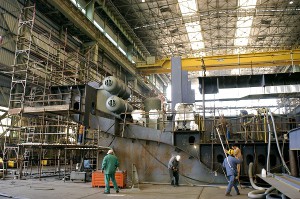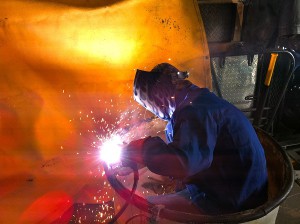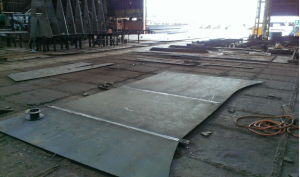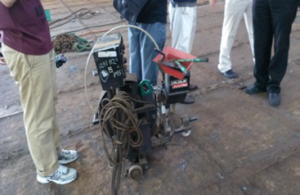 The goal of this ethnographic study is to understand welding practices in environments like yards, to design an interactive welding robot.
The goal of this ethnographic study is to understand welding practices in environments like yards, to design an interactive welding robot.
 The robot is aimed at helping workers in their daily work while it is distributed on a lifted plant. The robot design, including its user interface, were found to be a committing task due to the different problematic conditions that can arise in the yard. Like for instance dust, irregular ground, high temperature, wind variations, lifted work platforms, narrow spaces and circular paths that require a robotic welding with arms with more than 6 degrees of freedom. The document presents the results of some researchers’ observations on the field and of interviews with various welders, as well as engineering recommendations for robots for the successive design phase.
The robot is aimed at helping workers in their daily work while it is distributed on a lifted plant. The robot design, including its user interface, were found to be a committing task due to the different problematic conditions that can arise in the yard. Like for instance dust, irregular ground, high temperature, wind variations, lifted work platforms, narrow spaces and circular paths that require a robotic welding with arms with more than 6 degrees of freedom. The document presents the results of some researchers’ observations on the field and of interviews with various welders, as well as engineering recommendations for robots for the successive design phase. 
What are the most common welding practices in yards?
The welding processes typically used in shipyards are arc-welding processes: the high heat determined by an electric arc allows joining metal parts by using a consumer electrode. Most of welding workstations are implemented manually. Welders, in groups of three-four people, work independently. Each group is run by a senior supervisor, who assigns the daily work and controls that the welding is carried out according to the standards required. Before and after the welding, workers must clean the surface with metal brooms and brushes to remove metal parts and dust (see Fig. 1a). Some of the few automatic welding processes accomplished in the yard are FCAW welding processes. This type of welding is commonly used for T2-joints. The process is continuous, that is to say a machine welds plates along a long horizontal linear path (see Fig. 1b). On average, the automatic welding machine is three time faster than a human welder. Nevertheless, the machine can be used only for horizontal welding and only when the welding course is straight. Manual welding is the only option for variations as to the rectilinear course, as well as for edges or small repairs (see Fig. 1c). Another automatic welding process used in the yard is the SAW welding. In this case, two long metal surfaces are welded together in a head joint (see Fig. 2a) using an automated machine with granular flows (see Fig. 2b). Before starting the SAW welding, the metal surfaces must be first cut using a special cutting machine and then moved from the cutting place to the welding position.
The advantages of automation
Welding is not a difficult process and we can learn it easily but the process mastery takes time. Mechanizing some processes involved in the yard is a committing task but the effort is worthwhile. The exploitation of a robot would increase the productivity and would protect human welders from the exposure to all kinds of risks, for instance electrical, fires, damages to eyes, fall from a lifted position and so on. The next step consists in defining different contexts of robot use cases and in testing them in the yard. They will consider different set-up parameters and afterwards they will evaluate them during the experimentation phase. It is anyway necessary to find a reliable solution to obtain feedbacks about parameter regulations because it is impossible to reproduce the human skill of “feeling” in a robot. Finally, they are working to develop the first prototype with an interactive interface combining different suitable input/output modalities for communicating with the robot.



